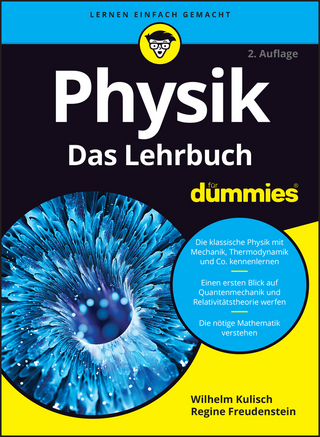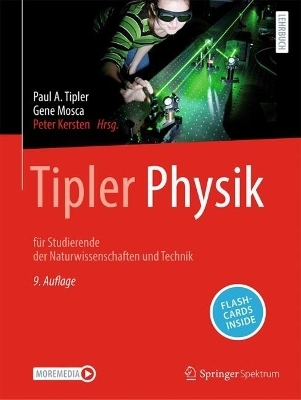
How to Understand Quantum Mechanics
Seiten
2018
Morgan & Claypool Publishers (Verlag)
978-1-68174-162-8 (ISBN)
Morgan & Claypool Publishers (Verlag)
978-1-68174-162-8 (ISBN)
Presents an accessible introduction to understanding quantum mechanics in a natural and intuitive way. A theoretical physicist reveals dozens of easy tricks that avoid long calculations, makes complicated things simple, and bypasses the worthless anguish of famous scientists who died in angst.
How to Understand Quantum Mechanics presents an accessible introduction to understanding quantum mechanics in a natural and intuitive way, which was advocated by Erwin Schroedinger and Albert Einstein. A theoretical physicist reveals dozens of easy tricks that avoid long calculations, makes complicated things simple, and bypasses the worthless anguish of famous scientists who died in angst. The author's approach is light-hearted, and the book is written to be read without equations, however all relevant equations still appear with explanations as to what they mean. The book entertainingly rejects quantum disinformation, the MKS unit system (obsolete), pompous non-explanations, pompous people, the hoax of the 'uncertainty principle' (it is just a math relation), and the accumulated junk-DNA that got into the quantum operating system by misreporting it. The order of presentation is new and also unique by warning about traps to be avoided, while separating topics such as quantum probability to let the Schroedinger equation be appreciated in the simplest way on its own terms. This is also the first book on quantum theory that is not based on arbitrary and confusing axioms or foundation principles. The author is so unprincipled he shows where obsolete principles duplicated basic math facts, became redundant, and sometimes were just pawns in academic turf wars. The book has many original topics not found elsewhere, and completely researched references to original historical sources and anecdotes concerting the unrecognized scientists who actually did discover things, did not all get Nobel prizes, and yet had interesting productive lives.
How to Understand Quantum Mechanics presents an accessible introduction to understanding quantum mechanics in a natural and intuitive way, which was advocated by Erwin Schroedinger and Albert Einstein. A theoretical physicist reveals dozens of easy tricks that avoid long calculations, makes complicated things simple, and bypasses the worthless anguish of famous scientists who died in angst. The author's approach is light-hearted, and the book is written to be read without equations, however all relevant equations still appear with explanations as to what they mean. The book entertainingly rejects quantum disinformation, the MKS unit system (obsolete), pompous non-explanations, pompous people, the hoax of the 'uncertainty principle' (it is just a math relation), and the accumulated junk-DNA that got into the quantum operating system by misreporting it. The order of presentation is new and also unique by warning about traps to be avoided, while separating topics such as quantum probability to let the Schroedinger equation be appreciated in the simplest way on its own terms. This is also the first book on quantum theory that is not based on arbitrary and confusing axioms or foundation principles. The author is so unprincipled he shows where obsolete principles duplicated basic math facts, became redundant, and sometimes were just pawns in academic turf wars. The book has many original topics not found elsewhere, and completely researched references to original historical sources and anecdotes concerting the unrecognized scientists who actually did discover things, did not all get Nobel prizes, and yet had interesting productive lives.
John P. Ralston, PhD, is a Professor of Physics and Astronomy at The University of Kansas. He received his PhD in high-energy theory physics from the University of Oregon. His research interests include high-energy theory, single-molecule methods, and pharmaceutical data analysis.
Preface
Author biography
1. The continuum Universe
2. Everything is a wave
3. There is no classical theory of matter
4. Matter waves
5. More quantumy experiments
6. Atoms are musical instruments
7. Waves with known solutions
8. Observables
9. More ways to describe waves
10. Entanglement
| Erscheinungsdatum | 14.06.2018 |
|---|---|
| Reihe/Serie | IOP Concise Physics |
| Verlagsort | San Rafael |
| Sprache | englisch |
| Maße | 178 x 254 mm |
| Gewicht | 525 g |
| Themenwelt | Naturwissenschaften ► Physik / Astronomie ► Allgemeines / Lexika |
| Naturwissenschaften ► Physik / Astronomie ► Quantenphysik | |
| Naturwissenschaften ► Physik / Astronomie ► Theoretische Physik | |
| ISBN-10 | 1-68174-162-8 / 1681741628 |
| ISBN-13 | 978-1-68174-162-8 / 9781681741628 |
| Zustand | Neuware |
| Haben Sie eine Frage zum Produkt? |
Mehr entdecken
aus dem Bereich
aus dem Bereich
Band 1: Mechanik und Thermodynamik
Buch | Softcover (2022)
Wiley-VCH (Verlag)
39,90 €
für Studierende der Naturwissenschaften und Technik
Buch (2024)
Springer Spektrum (Verlag)
79,99 €


